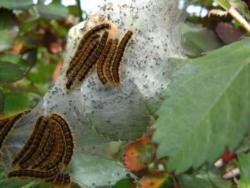Unused stories
Pest of the Month - Foliage-feeding caterpillars
First you see them, then you don't...
Those glossy new leaves that cloaked the branches on your dwarf fruit tree seemed to disappear overnight! Same with the succulent mahogany-colored foliage on your prize rose plant and the prickly leathery leaves on a large chunk of your California live oak. What’s up with that? Even your sleuthing with a magnifying lens doesn’t reveal anything obvious – other than some of the ragged, chewed leaves left behind. You may be hosting one or more types of caterpillars, all wreaking havoc while you sleep.

Some of the more common foliage-feeding caterpillars in our area include the California oakworm, Phryganidia californica, that feasts on oaks, the Western tussock moth, Orgyia vetusta, consumes most species of evergreen or deciduous trees, the Western tent caterpillar, Malacosoma californicum, prefers deciduous trees and shrubs, and both the Omnivorous looper, Sabulodes aegrotata and Fruittree leafrollers, Archips species, attack a wide range of plants.
These little eating machines have a cylindrical body and a well developed head with biting/chewing mouthparts. Moths and butterflies go through a complete metamorphosis. After mating, the female lays her eggs singly or in a mass on the host plant. The eggs of most species hatch after several days and the emerging larvae move singly or in groups to feeding sites on the plant. They will eat voraciously and grow rapidly shedding old skins three to five times before entering an inactive pupal stage; the adult moth or butterfly emerges from the pupal case after several days to several months depending on the species and season. Some common caterpillar pests, such as the fruittree leafroller and most tussock moths, have one generation a year. Others have several generations each year and can cause damage throughout the growing season.
If you don’t want these pesky guys in your garden (it may be a trade off if you’re interested in the adult), then mechanical removal is the easiest and safest means of control. Cut off any damaged or infested foliage and dispose of it (not in the compost pile!). Also check the bark and scrape any egg masses into a bucket of soapy water and dispose of them as well. Providing habitat that encourages general predators and parasites may help keep populations under control. If you decide to move to the next level of treatment, applications of the biological insecticide BT (Bacillus thuringiensis) applied when larvae are newly hatched will reduce populations of caterpillars that feed openly on foliage. This control is selective; it kills only caterpillars and is relatively safe for other insects, fish, birds and warm-blooded animals.
So, if you’re missing foliage and can’t find the culprit during the day, take a trip outdoors at night, flashlight in hand, and you might just find the hungry little beasts mowing through your leaves.
By Nanette Londeree
Photo – tent caterpillars decimating a rose bush in author’s garden
